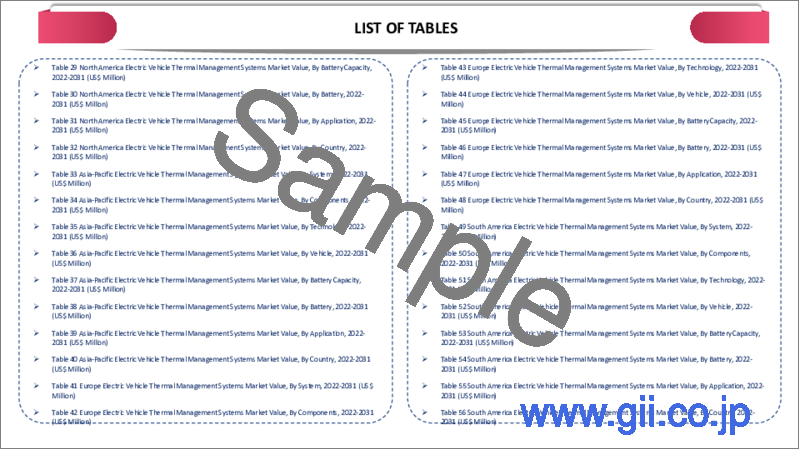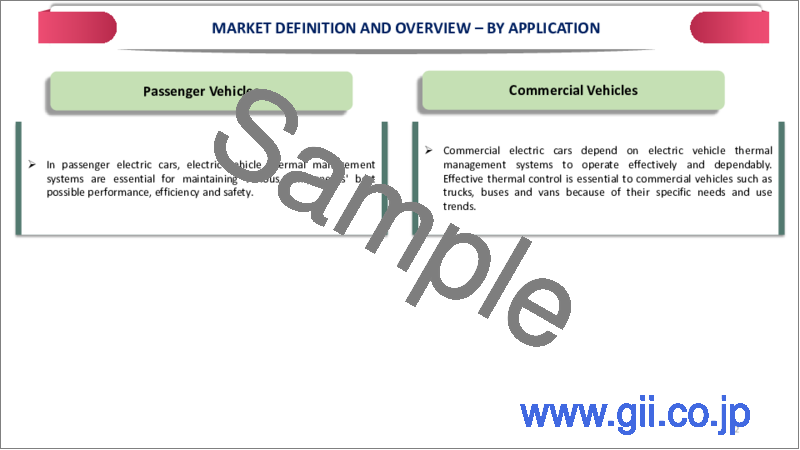|
|
市場調査レポート
商品コード
1336666
電気自動車用熱管理システムの世界市場-2023年~2030年Global Electric Vehicle Thermal Management Systems Market - 2023-2030 |
||||||
カスタマイズ可能
適宜更新あり
|
|||||||
| 電気自動車用熱管理システムの世界市場-2023年~2030年 |
|
出版日: 2023年08月22日
発行: DataM Intelligence
ページ情報: 英文 181 Pages
納期: 即日から翌営業日
|
- 全表示
- 概要
- 目次
市場概要
世界の電気自動車用熱管理システム市場は、2022年に32億米ドルに達し、2023-2030年の予測期間中にCAGR 20.6%で成長し、2030年には144億米ドルに達すると予測されています。
技術の進歩は、電気自動車用熱管理システム市場の成長と開拓を促進する上で重要な役割を果たしています。電気自動車産業が進化を続ける中、熱管理システムの新技術やイノベーションは、性能、効率、安全性の向上に寄与しています。熱管理技術の進歩は、電気自動車内の温度のより効果的な制御と調整を可能にします。
乗用車セグメントは市場の2/3以上のシェアを占めており、乗用車セグメントにおける電気自動車とハイブリッド車への需要の増加が、電気自動車用熱管理システム市場の主要な促進要因となっています。乗用車用EVはどこでも簡単に入手できるからです。さらに、複数の政府がEVの利用を促進するプログラムを立ち上げており、これがこの市場の拡大をさらに促進しています。
市場力学
電気自動車の普及拡大
電気自動車用熱管理システムは、主にEVの人気上昇によって牽引されています。従来の内燃エンジン車から電気自動車に乗り換える顧客や組織が増えるにつれて、効果的な熱管理システムの必要性が高まっています。電気自動車には、バッテリー、パワーエレクトロニクス、車内空調など、多数の部品の温度を制御するための高度な熱管理が必要です。
環境問題、政府の法律、バッテリーや充電インフラの進歩、その他の考慮事項のすべてが、電気自動車の採用に影響を与えています。電気自動車の市場が拡大するにつれ、電気自動車の運転に関連する特有の困難に対処するための強力な熱管理システムの需要が高まっています。
さらに、快適な運転体験のためには、バッテリーの熱管理に加えて、効果的な車内空調制御が欠かせません。熱管理システムは、暖房、換気、空調(HVAC)機能を提供することで、 促進要因と同乗者が好みの車内温度を維持できるようにします。
EV熱管理システムのバッテリー技術の進歩
電気自動車用熱管理システムの市場は、バッテリー技術の進歩により拡大しています。バッテリー技術の進歩により、よりパワフルで効率的な電気自動車が製造できるようになりました。バッテリー技術の進歩により、このような最新のバッテリーの温度を効率的に制御できる最新の熱管理システムが必要とされています。
さらに、高度なバッテリー技術は、電気自動車に使用されるバッテリーの全体的な強靭性と耐久性を向上させ、より長持ちするように作られています。バッテリーの温度を安定させ、容量を維持し、寿命を延ばすためには、適切な熱管理が不可欠です。
さらに、電気自動車の設計において重要な要素はバッテリーの安全性です。熱安定性の向上や熱暴走の危険性の低減といった安全機能は、バッテリー技術に追加された安全要素のひとつです。しかし、安全な作動温度を保証し、あらゆる安全リスクから守るためには、信頼性の高い熱管理システムが依然として必要です。
高い資本コストと研究開発コスト
自動車産業の平均的な車両は、組立ラインで製造される5年前に構想が練られます。車両に必要な機能システムが装備されていることを保証するために、自動車用バッテリーの熱管理システムは、構想段階かその1~2年後に組み込まれなければなりません。さらに、自動車システムの生産開発サイクルは2年近くかそれ以上続く。
さらに、自動車システムには自動車の安全性やセキュリティの側面も多く含まれるため、製品開発の複雑さと期間がさらに長くなります。しかし、家電製品の製品開発サイクルは1年未満であり、これらのバッテリー熱管理技術もよく似ているため、両事業の間にはミスマッチがあります。
さらに、彼らは自動車にも同じ特性を求めているが、自動車OEMがそれを実現するのは非常に困難です。毎年、より多くの最先端技術システムが市場に投入されるため、これらのOEMは常に障害に直面しています。
COVID-19影響分析
COVID-19は、特に製造業にパンデミックをもたらしました。旅行や輸送に規制が設けられたことで、市場は打撃を受けた。サプライ・チェーンの物流、貯蔵、倉庫の部分がさらに変化しました。世界中のいくつかの企業で製造活動が停止された結果、硫酸の需要が大幅に減少しました。
電気自動車用熱管理システムは、COVID-19が必需品を製造する工場を除くすべての工場の閉鎖を広範に決定した結果、需要が大幅に減少しました。政府はCOVID-19の蔓延を食い止めるため、非必需品の生産と販売の停止、国際商取引の制限など、さまざまな厳しい措置を実施しました。
目次
第1章 調査手法と調査範囲
第2章 定義と概要
第3章 エグゼクティブサマリー
第4章 市場力学
- 影響要因
- 促進要因
- 電気自動車と代替燃料自動車の需要増加
- 革新的技術を採用した新しいリチウムイオン電池
- 電気自動車の普及拡大
- 電気自動車用熱管理システムのバッテリー技術の進歩
- 抑制要因
- 熱効率の維持が困難
- 高い資本コストと研究開発コスト
- 機会
- 影響分析
- 促進要因
第5章 産業分析
- ポーターのファイブフォース分析
- サプライチェーン分析
- 価格分析
- 規制分析
第6章 COVID-19分析
第7章 システム別
- 暖房
- 換気
- 空調(HVAC)
- パワートレイン冷却
- 流体輸送
- その他
第8章 コンポーネント別
- バッテリー
- 発電
- キャビン
- モーター
第9章 テクノロジー別
- アクティブ
- パッシブ
第10章 推進方式別
- バッテリー式電気自動車(BEV)
- ハイブリッド車(HEV)
- プラグインハイブリッド車(PHEV)
- 燃料電池車(FCEV)
第11章 バッテリー容量別
- 30kWh未満
- 30~60 kWh
- 60~100 kWh
- 100kWh以上
第12章 バッテリー別
- 従来型
- 固体型
第13章 車両別
- 乗用車
- 商用車
第14章 地域別
- 北米
- 米国
- カナダ
- メキシコ
- 欧州
- ドイツ
- 英国
- フランス
- イタリア
- ロシア
- その他欧州
- 南米
- ブラジル
- アルゼンチン
- その他南米
- アジア太平洋
- 中国
- インド
- 日本
- オーストラリア
- その他アジア太平洋
- 中東・アフリカ
第15章 競合情勢
- 競合シナリオ
- 市況/シェア分析
- M&A分析
第16章 企業プロファイル
- BorgWarner Inc.
- 会社概要
- 製品ポートフォリオと説明
- 財務概要
- 主な動向
- Mahle GmbH
- Valeo SA
- Hanon Systems
- Denso Corporation
- Gentherm Incorporated
- LG Electronics Inc.
- Continental AG
- Dana Incorporated
- Modine Manufacturing Company
第17章 付録
Market Overview
Global Electric Vehicle Thermal Management Systems Market reached US$ 3.2 billion in 2022 and is expected to reach US$ 14.4 billion by 2030, growing with a CAGR of 20.6% during the forecast period 2023-2030.
Technological advancements play a significant role in driving the growth and development of the electric vehicle thermal management systems market. As the electric vehicle industry continues to evolve, new technologies and innovations in thermal management systems contribute to improved performance, efficiency and safety. Advancements in thermal management technologies enable more effective control and regulation of temperature within electric vehicles.
The passenger vehicles segment holds more than 2/3rd share in the market and the increasing demand for electric and hybrid vehicles in the passenger vehicle segment is a major driver for the electric vehicle thermal management systems market. Because passenger EVs are readily available everywhere. Additionally, several governments are launching programs to promote the use of EVs, which is further promoting the expansion of this market.
Market Dynamics
Increasing Electric Vehicle Adoption
Electric vehicle thermal management systems are primarily driven by the rising popularity of EVs. The need for effective thermal management systems grows as more customers and organizations switch from conventional internal combustion engine vehicles to electric vehicles. Electric cars need sophisticated thermal management to control the temperature of numerous parts, including the battery, power electronics and cabin climate control.
Environmental concerns, governmental laws, advances in the battery and charging infrastructure, as well as other considerations, have all influenced the adoption of electric cars. As the market for electric vehicles grows, there is an increasing demand for powerful thermal management systems to handle the particular difficulties associated with operating an electric vehicle.
Additionally, Effective cabin climate control, in addition to battery thermal management, is crucial for a comfortable driving experience. By offering heating, ventilation and air conditioning (HVAC) capabilities, thermal management systems enable drivers and passengers to maintain preferred cabin temperatures.
Advancements In Battery Technology of EV Thermal Management Systems
The market for electric vehicle thermal management systems is expanding as a result of advancements in battery technology. Electric cars may now be made that are more powerful and efficient thanks to advancements in battery technology. Modern thermal management systems that can efficiently control the temperature of these modern batteries are needed as a result of the advancement of battery technology.
Furthermore, advanced battery technologies are made to last longer, improving the overall toughness and endurance of the batteries used in electric vehicles. In order to keep the battery's temperature stable, which helps maintain its capacity and lengthen its operating life, proper thermal management is essential.
Additionally, the significant factor in the design of electric vehicles is battery safety. Safety features like improved thermal stability and a lower danger of thermal runaway are among the safety elements that have been added to battery technology. However, to guarantee safe operating temperatures and guard against any safety risks, reliable thermal management systems are still required.
High Capital and Research and Development Costs
The average vehicle in the automobile industry is conceptualized five years before it is built on an assembly line. To guarantee that the vehicle is outfitted with the necessary functionality systems, the automotive battery thermal management system must be included either during the conception phase or 1-2 years afterward. Furthermore, the automobile system's production development cycle lasts for close to or longer than two years.
In the addition of many safety and security aspects of the vehicle are included in automotive systems, which adds to the complexity and length of time required for product development. However, because consumer electronics have a product development cycle of less than a year and these battery thermal management technologies are quite similar, there is a mismatch between the two businesses.
Additionally, they want the same characteristics in a car, which an automobile OEM finds extremely challenging to deliver. As more cutting-edge technical systems are released onto the market each year, these OEMs are constantly faced with obstacles.
COVID-19 Impact Analysis
A pandemic was brought on by COVID-19, especially for the manufacturing sector. The market was harmed by all of the restrictions placed on travel and transportation. further alterations to the logistics, storage and warehousing portions of the supply chain. The demand for sulfuric acid has significantly decreased as a result of the suspension of manufacturing activities in several businesses throughout the world
Electric vehicle thermal management systems saw a large decline in demand as a result of COVID-19's widespread decision to close all factories save from those that manufacture necessities. The government has implemented a variety of stringent measures, such as stopping the production and sale of non-essential goods and restricting international commerce, to stop the spread of COVID-19.
Segment Analysis
The global electric vehicle thermal management systems market is segmented based on system, components, technology, propulsion, battery capacity, battery, vehicle and region.
Rising Demand for Battery Electric Vehicles (BEVs) Because of falling Battery Prices
The Battery Electric Vehicles (BEVs) segment holds more than 25.9% share of the global electric vehicle thermal management systems market. The most popular and successful BEV vehicles in 2016 were the Nissan Leaf and Tesla Model S. Because of falling battery prices, rising customer concern for the environment and slashed charge times, the BEV category is expected to continue to rise throughout the projection period.
Electric vehicles may theoretically be fully charged in under an hour thanks to the development of ultra-rapid chargers. In addition to HEVs, FCVs and PHEVs, zero-emission vehicles, or BEVs, are expected to have the biggest market share in the electric vehicle class due to the availability of government incentives and assistance. For instance, in nations like China, BEVs, which emit no emissions, receive more subsidies than PHEVs and HEVs.
Geographical Analysis
North America Growing Quick Development of Infrastructure Facilities
The availability of significant market participants and the quick development of infrastructure facilities in growing economies in North America is predicted to increase throughout the projected period covering more than 35.4% gloally. In addition, rising per-capita income and private and governmental investment in the infrastructure of the chemicals sector in developing and underdeveloped nations are anticipated to drive the market's growth rate in North America.
Another crucial factor influencing market expansion is the advantages of these goods, such as increased efficiency and extended battery life, as well as the expanding presence of prominent manufacturers in this industry. The expansion of the market for Electric Vehicle Thermal Management Systems in North America has been significantly fueled by government assistance and incentives.
For instance, the federal government of U.S. provides tax credits of up to US$ 7,500 for the purchase of eligible electric cars. In addition, several states offer further incentives like grants, refunds and exemptions from sales tax or registration costs. These incentives encourage people to choose cleaner, more environmentally friendly modes of transportation while also lowering the initial cost of electric automobiles.
Competitive Landscape
The major global players include: BorgWarner Inc., Mahle GmbH, Valeo SA, Hanon Systems, Denso Corporation, Gentherm Incorporated, LG Electronics Inc., Continental AG, Dana Incorporated and Modine Manufacturing Company.
Why Purchase the Report?
- To visualize the global electric vehicle thermal management systems market segmentation based on system, components, technology, propulsion, battery capacity, battery, vehicle and region, as well as understand key commercial assets and players.
- Identify commercial opportunities by analyzing trends and co-development.
- Excel data sheet with numerous data points of electric vehicle thermal management systems market-level with all segments.
- PDF report consists of a comprehensive analysis after exhaustive qualitative interviews and an in-depth study.
- Product mapping available as excel consisting of key products of all the major players.
The global electric vehicle thermal management systems market report would provide approximately 94 tables, 100 figures and 181 pages.
Target Audience 2023
- Manufacturers/ Buyers
- Industry Investors/Investment Bankers
- Research Professionals
- Emerging Companies
Table of Contents
1. Methodology and Scope
- 1.1. Research Methodology
- 1.2. Research Objective and Scope of the Report
2. Definition and Overview
3. Executive Summary
- 3.1. Snippet by System
- 3.2. Snippet by Components
- 3.3. Snippet by Technology
- 3.4. Snippet by Propulsion
- 3.5. Snippet by Battery Capacity
- 3.6. Snippet by Battery
- 3.7. Snippet by Vehicle
- 3.8. Snippet by Region
4. Dynamics
- 4.1. Impacting Factors
- 4.1.1. Drivers
- 4.1.1.1. Increasing Demand for Electric and Alternative Fuel Vehicles
- 4.1.1.2. New Lithium-Ion Batteries Feature Innovative Technology
- 4.1.1.3. Increasing Electric Vehicle Adoption
- 4.1.1.4. Advancements In Battery Technology Of EV Thermal Management Systems
- 4.1.2. Restraints
- 4.1.2.1. Difficulty in Maintaining Thermal Efficiency
- 4.1.2.2. High Capital and Research and Development Costs
- 4.1.3. Opportunity
- 4.1.4. Impact Analysis
- 4.1.1. Drivers
5. Industry Analysis
- 5.1. Porter's Five Force Analysis
- 5.2. Supply Chain Analysis
- 5.3. Pricing Analysis
- 5.4. Regulatory Analysis
6. COVID-19 Analysis
- 6.1. Analysis of COVID-19
- 6.1.1. Scenario Before COVID
- 6.1.2. Scenario During COVID
- 6.1.3. Scenario Post COVID
- 6.2. Pricing Dynamics Amid COVID-19
- 6.3. Demand-Supply Spectrum
- 6.4. Government Initiatives Related to the Market During Pandemic
- 6.5. Manufacturers Strategic Initiatives
- 6.6. Conclusion
7. By System
- 7.1. Introduction
- 7.1.1. Market Size Analysis and Y-o-Y Growth Analysis (%), By System
- 7.1.2. Market Attractiveness Index, By System
- 7.2. Heating*
- 7.2.1. Introduction
- 7.2.2. Market Size Analysis and Y-o-Y Growth Analysis (%)
- 7.3. Ventilation
- 7.4. Air Conditioning (HVAC)
- 7.5. Powertrain Cooling
- 7.6. Fluid Transport
- 7.7. Others
8. By Components
- 8.1. Introduction
- 8.1.1. Market Size Analysis and Y-o-Y Growth Analysis (%), By Components
- 8.1.2. Market Attractiveness Index, By Components
- 8.2. Battery*
- 8.2.1. Introduction
- 8.2.2. Market Size Analysis and Y-o-Y Growth Analysis (%)
- 8.3. Power Generation
- 8.4. Cabin
- 8.5. Motor
9. By Technology
- 9.1. Introduction
- 9.1.1. Market Size Analysis and Y-o-Y Growth Analysis (%), By Technology
- 9.1.2. Market Attractiveness Index, By Technology
- 9.2. Active*
- 9.2.1. Introduction
- 9.2.2. Market Size Analysis and Y-o-Y Growth Analysis (%)
- 9.3. Passive
10. By Propulsion
- 10.1. Introduction
- 10.1.1. Market Size Analysis and Y-o-Y Growth Analysis (%), By Propulsion
- 10.1.2. Market Attractiveness Index, By Propulsion
- 10.2. Battery Electric Vehicle (BEV) *
- 10.2.1. Introduction
- 10.2.2. Market Size Analysis and Y-o-Y Growth Analysis (%)
- 10.3. Hybrid Electric Vehicle (HEV)
- 10.4. Plug-in Hybrid Electric Vehicle (PHEV)
- 10.5. Fuel Cell Electric Vehicle (FCEV)
11. By Battery Capacity
- 11.1. Introduction
- 11.1.1. Market Size Analysis and Y-o-Y Growth Analysis (%), By Battery Capacity
- 11.1.2. Market Attractiveness Index, By Battery Capacity
- 11.2. Below 30 kWh*
- 11.2.1. Introduction
- 11.2.2. Market Size Analysis and Y-o-Y Growth Analysis (%)
- 11.3. 30 - 60 kWh
- 11.4. 60 - 100 kWh
- 11.5. Above 100 kWh
12. By Battery
- 12.1. Introduction
- 12.1.1. Market Size Analysis and Y-o-Y Growth Analysis (%), By Battery
- 12.1.2. Market Attractiveness Index, By Battery
- 12.2. Conventional*
- 12.2.1. Introduction
- 12.2.2. Market Size Analysis and Y-o-Y Growth Analysis (%)
- 12.3. Solid- State
13. By Vehicle
- 13.1. Introduction
- 13.1.1. Market Size Analysis and Y-o-Y Growth Analysis (%), By Vehicle
- 13.1.2. Market Attractiveness Index, By Vehicle
- 13.2. Passenger Vehicles *
- 13.2.1. Introduction
- 13.2.2. Market Size Analysis and Y-o-Y Growth Analysis (%)
- 13.3. Commercial Vehicles
14. By Region
- 14.1. Introduction
- 14.1.1. Market Size Analysis and Y-o-Y Growth Analysis (%), By Region
- 14.1.2. Market Attractiveness Index, By Region
- 14.2. North America
- 14.2.1. Introduction
- 14.2.2. Key Region-Specific Dynamics
- 14.2.3. Market Size Analysis and Y-o-Y Growth Analysis (%), By System
- 14.2.4. Market Size Analysis and Y-o-Y Growth Analysis (%), By Components
- 14.2.5. Market Size Analysis and Y-o-Y Growth Analysis (%), By Technology
- 14.2.6. Market Size Analysis and Y-o-Y Growth Analysis (%), By Propulsion
- 14.2.7. Market Size Analysis and Y-o-Y Growth Analysis (%), By Battery Capacity
- 14.2.8. Market Size Analysis and Y-o-Y Growth Analysis (%), By Battery
- 14.2.9. Market Size Analysis and Y-o-Y Growth Analysis (%), By Vehicle
- 14.2.10. Market Size Analysis and Y-o-Y Growth Analysis (%), By Country
- 14.2.10.1. U.S.
- 14.2.10.2. Canada
- 14.2.10.3. Mexico
- 14.3. Europe
- 14.3.1. Introduction
- 14.3.2. Key Region-Specific Dynamics
- 14.3.3. Market Size Analysis and Y-o-Y Growth Analysis (%), By System
- 14.3.4. Market Size Analysis and Y-o-Y Growth Analysis (%), By Components
- 14.3.5. Market Size Analysis and Y-o-Y Growth Analysis (%), By Technology
- 14.3.6. Market Size Analysis and Y-o-Y Growth Analysis (%), By Propulsion
- 14.3.7. Market Size Analysis and Y-o-Y Growth Analysis (%), By Battery Capacity
- 14.3.8. Market Size Analysis and Y-o-Y Growth Analysis (%), By Battery
- 14.3.9. Market Size Analysis and Y-o-Y Growth Analysis (%), By Vehicle
- 14.3.10. Market Size Analysis and Y-o-Y Growth Analysis (%), By Country
- 14.3.10.1. Germany
- 14.3.10.2. UK
- 14.3.10.3. France
- 14.3.10.4. Italy
- 14.3.10.5. Russia
- 14.3.10.6. Rest of Europe
- 14.4. South America
- 14.4.1. Introduction
- 14.4.2. Key Region-Specific Dynamics
- 14.4.3. Market Size Analysis and Y-o-Y Growth Analysis (%), By System
- 14.4.4. Market Size Analysis and Y-o-Y Growth Analysis (%), By Components
- 14.4.5. Market Size Analysis and Y-o-Y Growth Analysis (%), By Technology
- 14.4.6. Market Size Analysis and Y-o-Y Growth Analysis (%), By Propulsion
- 14.4.7. Market Size Analysis and Y-o-Y Growth Analysis (%), By Battery Capacity
- 14.4.8. Market Size Analysis and Y-o-Y Growth Analysis (%), By Battery
- 14.4.9. Market Size Analysis and Y-o-Y Growth Analysis (%), By Vehicle
- 14.4.10. Market Size Analysis and Y-o-Y Growth Analysis (%), By Country
- 14.4.10.1. Brazil
- 14.4.10.2. Argentina
- 14.4.10.3. Rest of South America
- 14.5. Asia-Pacific
- 14.5.1. Introduction
- 14.5.2. Key Region-Specific Dynamics
- 14.5.3. Market Size Analysis and Y-o-Y Growth Analysis (%), By System
- 14.5.4. Market Size Analysis and Y-o-Y Growth Analysis (%), By Components
- 14.5.5. Market Size Analysis and Y-o-Y Growth Analysis (%), By Technology
- 14.5.6. Market Size Analysis and Y-o-Y Growth Analysis (%), By Propulsion
- 14.5.7. Market Size Analysis and Y-o-Y Growth Analysis (%), By Battery Capacity
- 14.5.8. Market Size Analysis and Y-o-Y Growth Analysis (%), By Battery
- 14.5.9. Market Size Analysis and Y-o-Y Growth Analysis (%), By Vehicle
- 14.5.10. Market Size Analysis and Y-o-Y Growth Analysis (%), By Country
- 14.5.10.1. China
- 14.5.10.2. India
- 14.5.10.3. Japan
- 14.5.10.4. Australia
- 14.5.10.5. Rest of Asia-Pacific
- 14.6. Middle East and Africa
- 14.6.1. Introduction
- 14.6.2. Key Region-Specific Dynamics
- 14.6.3. Market Size Analysis and Y-o-Y Growth Analysis (%), By System
- 14.6.4. Market Size Analysis and Y-o-Y Growth Analysis (%), By Components
- 14.6.5. Market Size Analysis and Y-o-Y Growth Analysis (%), By Technology
- 14.6.6. Market Size Analysis and Y-o-Y Growth Analysis (%), By Propulsion
- 14.6.7. Market Size Analysis and Y-o-Y Growth Analysis (%), By Battery Capacity
- 14.6.8. Market Size Analysis and Y-o-Y Growth Analysis (%), By Battery
- 14.6.9. Market Size Analysis and Y-o-Y Growth Analysis (%), By Vehicle
15. Competitive Landscape
- 15.1. Competitive Scenario
- 15.2. Market Positioning/Share Analysis
- 15.3. Mergers and Acquisitions Analysis
16. Company Profiles
- 16.1. BorgWarner Inc.*
- 16.1.1. Company Overview
- 16.1.2. Product Portfolio and Description
- 16.1.3. Financial Overview
- 16.1.4. Key Developments
- 16.2. Mahle GmbH
- 16.3. Valeo SA
- 16.4. Hanon Systems
- 16.5. Denso Corporation
- 16.6. Gentherm Incorporated
- 16.7. LG Electronics Inc.
- 16.8. Continental AG
- 16.9. Dana Incorporated
- 16.10. Modine Manufacturing Company
LIST NOT EXHAUSTIVE
17.Appendix
- 17.1 About Us and Services
- 17.2 Contact Us





